Financial Analysis & Improvement Strategies: Detailed Report
VerifiedAdded on 2023/06/12
|14
|2605
|91
Report
AI Summary
This report provides a comprehensive analysis of financial management principles and their application in improving business performance. It begins by defining financial management and its importance in maintaining cash balances, ensuring returns on investments, and promoting proper fund utilization. The report then delves into financial statements, including the balance sheet, profit and loss statement, and cash flow statement, explaining their components and significance. Financial ratios, such as profitability, liquidity, and efficiency ratios, are discussed as tools for performance monitoring and future planning. A case study is used to demonstrate the application of these ratios in analyzing a firm's position. Finally, the report explores strategies for improving financial performance, emphasizing the importance of identifying and eliminating unnecessary expenditures, enhancing advertising methods, and refining collection policies. The report concludes that financial management is crucial for setting up and supervising a company's finances, and that financial statements and ratios are essential for assessing its performance and making informed decisions.
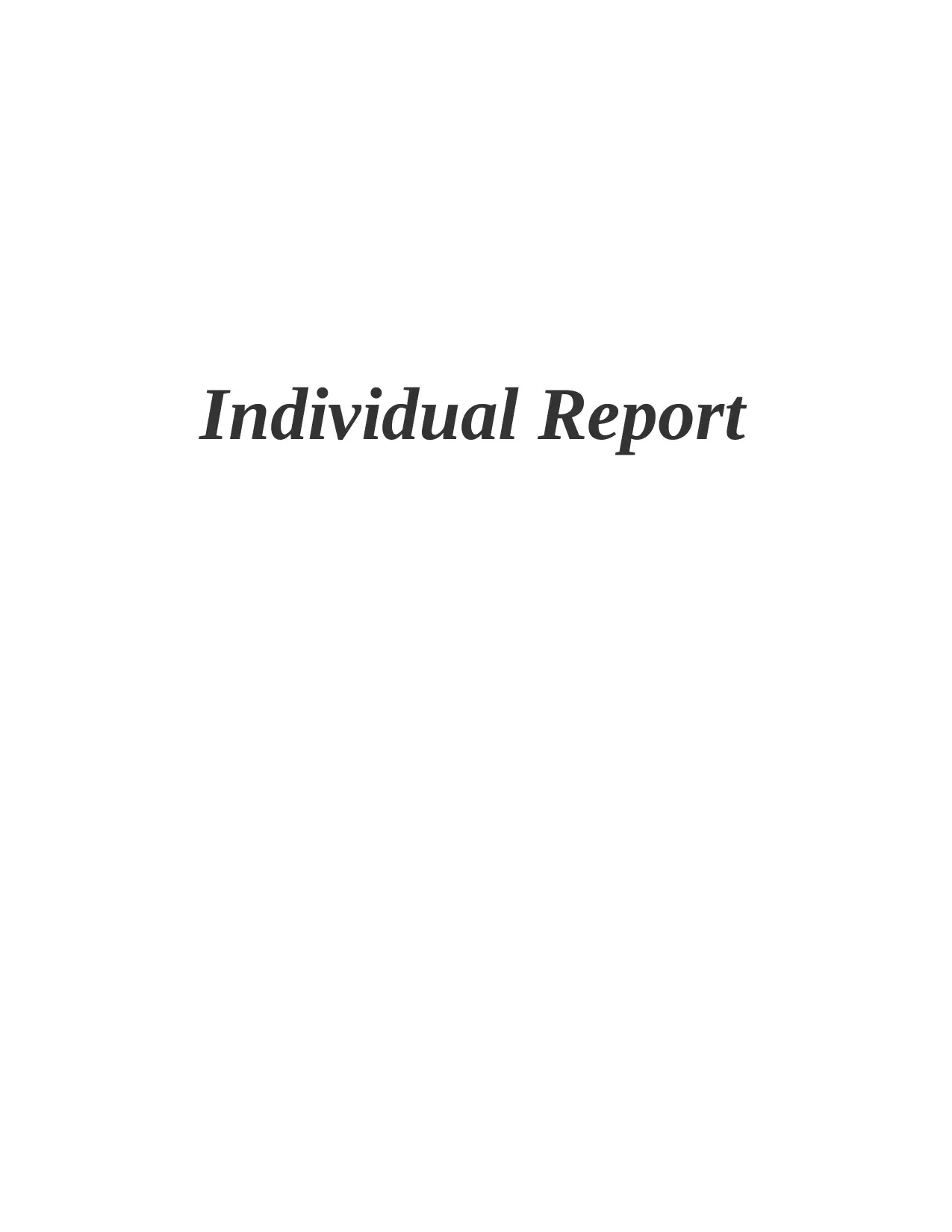
Individual Report
Paraphrase This Document
Need a fresh take? Get an instant paraphrase of this document with our AI Paraphraser
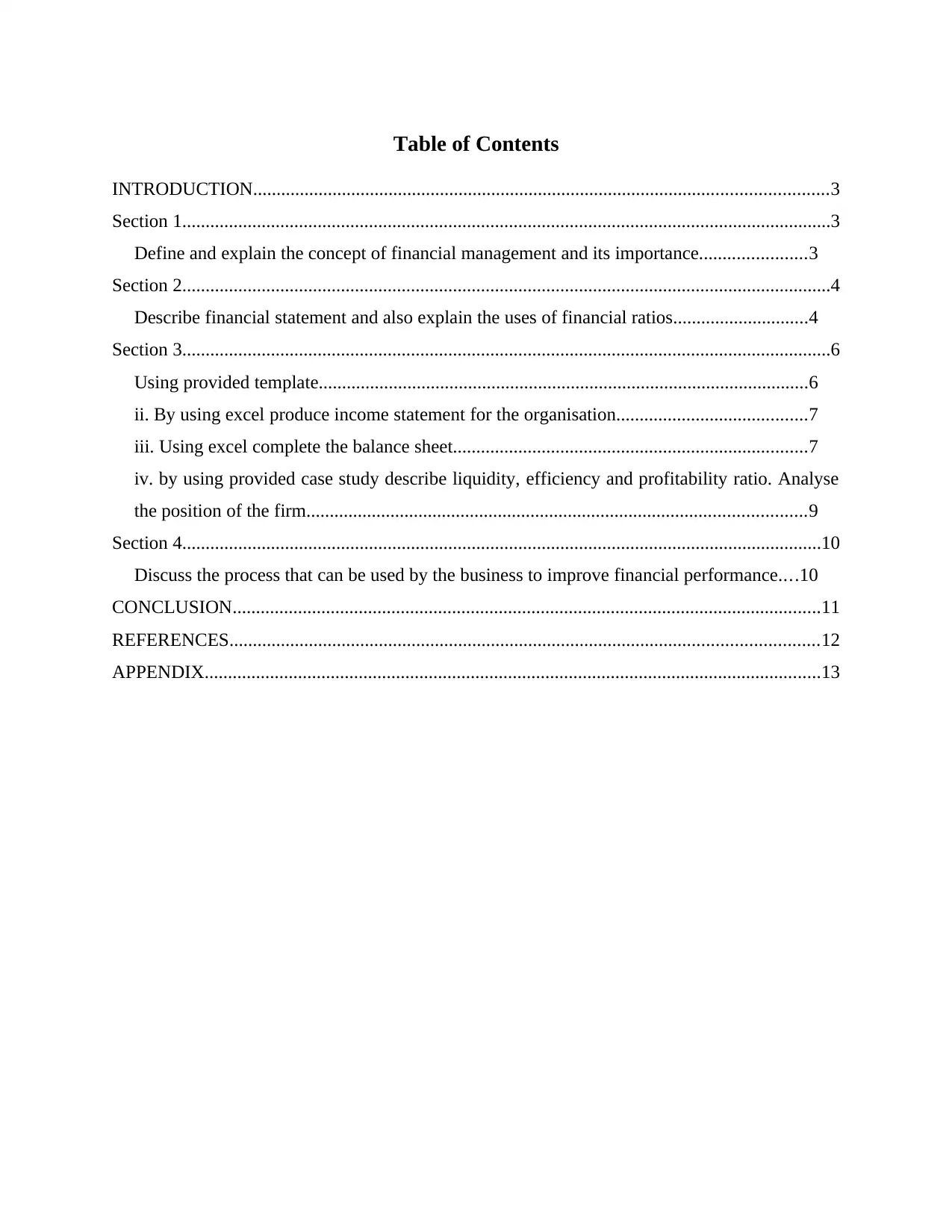
Table of Contents
INTRODUCTION...........................................................................................................................3
Section 1...........................................................................................................................................3
Define and explain the concept of financial management and its importance.......................3
Section 2...........................................................................................................................................4
Describe financial statement and also explain the uses of financial ratios.............................4
Section 3...........................................................................................................................................6
Using provided template.........................................................................................................6
ii. By using excel produce income statement for the organisation.........................................7
iii. Using excel complete the balance sheet............................................................................7
iv. by using provided case study describe liquidity, efficiency and profitability ratio. Analyse
the position of the firm...........................................................................................................9
Section 4.........................................................................................................................................10
Discuss the process that can be used by the business to improve financial performance....10
CONCLUSION..............................................................................................................................11
REFERENCES..............................................................................................................................12
APPENDIX....................................................................................................................................13
INTRODUCTION...........................................................................................................................3
Section 1...........................................................................................................................................3
Define and explain the concept of financial management and its importance.......................3
Section 2...........................................................................................................................................4
Describe financial statement and also explain the uses of financial ratios.............................4
Section 3...........................................................................................................................................6
Using provided template.........................................................................................................6
ii. By using excel produce income statement for the organisation.........................................7
iii. Using excel complete the balance sheet............................................................................7
iv. by using provided case study describe liquidity, efficiency and profitability ratio. Analyse
the position of the firm...........................................................................................................9
Section 4.........................................................................................................................................10
Discuss the process that can be used by the business to improve financial performance....10
CONCLUSION..............................................................................................................................11
REFERENCES..............................................................................................................................12
APPENDIX....................................................................................................................................13
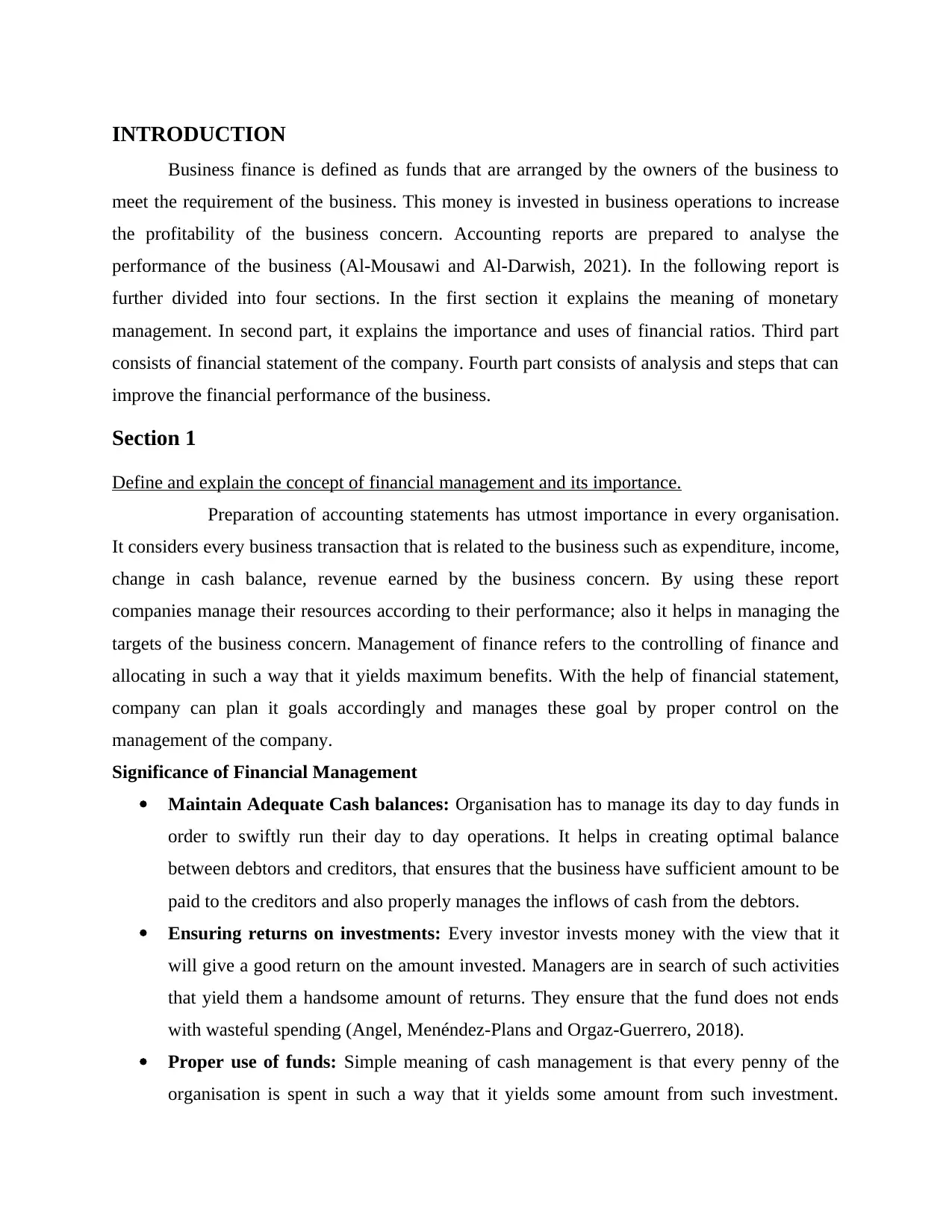
INTRODUCTION
Business finance is defined as funds that are arranged by the owners of the business to
meet the requirement of the business. This money is invested in business operations to increase
the profitability of the business concern. Accounting reports are prepared to analyse the
performance of the business (Al-Mousawi and Al-Darwish, 2021). In the following report is
further divided into four sections. In the first section it explains the meaning of monetary
management. In second part, it explains the importance and uses of financial ratios. Third part
consists of financial statement of the company. Fourth part consists of analysis and steps that can
improve the financial performance of the business.
Section 1
Define and explain the concept of financial management and its importance.
Preparation of accounting statements has utmost importance in every organisation.
It considers every business transaction that is related to the business such as expenditure, income,
change in cash balance, revenue earned by the business concern. By using these report
companies manage their resources according to their performance; also it helps in managing the
targets of the business concern. Management of finance refers to the controlling of finance and
allocating in such a way that it yields maximum benefits. With the help of financial statement,
company can plan it goals accordingly and manages these goal by proper control on the
management of the company.
Significance of Financial Management
Maintain Adequate Cash balances: Organisation has to manage its day to day funds in
order to swiftly run their day to day operations. It helps in creating optimal balance
between debtors and creditors, that ensures that the business have sufficient amount to be
paid to the creditors and also properly manages the inflows of cash from the debtors.
Ensuring returns on investments: Every investor invests money with the view that it
will give a good return on the amount invested. Managers are in search of such activities
that yield them a handsome amount of returns. They ensure that the fund does not ends
with wasteful spending (Angel, Menéndez-Plans and Orgaz-Guerrero, 2018).
Proper use of funds: Simple meaning of cash management is that every penny of the
organisation is spent in such a way that it yields some amount from such investment.
Business finance is defined as funds that are arranged by the owners of the business to
meet the requirement of the business. This money is invested in business operations to increase
the profitability of the business concern. Accounting reports are prepared to analyse the
performance of the business (Al-Mousawi and Al-Darwish, 2021). In the following report is
further divided into four sections. In the first section it explains the meaning of monetary
management. In second part, it explains the importance and uses of financial ratios. Third part
consists of financial statement of the company. Fourth part consists of analysis and steps that can
improve the financial performance of the business.
Section 1
Define and explain the concept of financial management and its importance.
Preparation of accounting statements has utmost importance in every organisation.
It considers every business transaction that is related to the business such as expenditure, income,
change in cash balance, revenue earned by the business concern. By using these report
companies manage their resources according to their performance; also it helps in managing the
targets of the business concern. Management of finance refers to the controlling of finance and
allocating in such a way that it yields maximum benefits. With the help of financial statement,
company can plan it goals accordingly and manages these goal by proper control on the
management of the company.
Significance of Financial Management
Maintain Adequate Cash balances: Organisation has to manage its day to day funds in
order to swiftly run their day to day operations. It helps in creating optimal balance
between debtors and creditors, that ensures that the business have sufficient amount to be
paid to the creditors and also properly manages the inflows of cash from the debtors.
Ensuring returns on investments: Every investor invests money with the view that it
will give a good return on the amount invested. Managers are in search of such activities
that yield them a handsome amount of returns. They ensure that the fund does not ends
with wasteful spending (Angel, Menéndez-Plans and Orgaz-Guerrero, 2018).
Proper use of funds: Simple meaning of cash management is that every penny of the
organisation is spent in such a way that it yields some amount from such investment.
⊘ This is a preview!⊘
Do you want full access?
Subscribe today to unlock all pages.

Trusted by 1+ million students worldwide
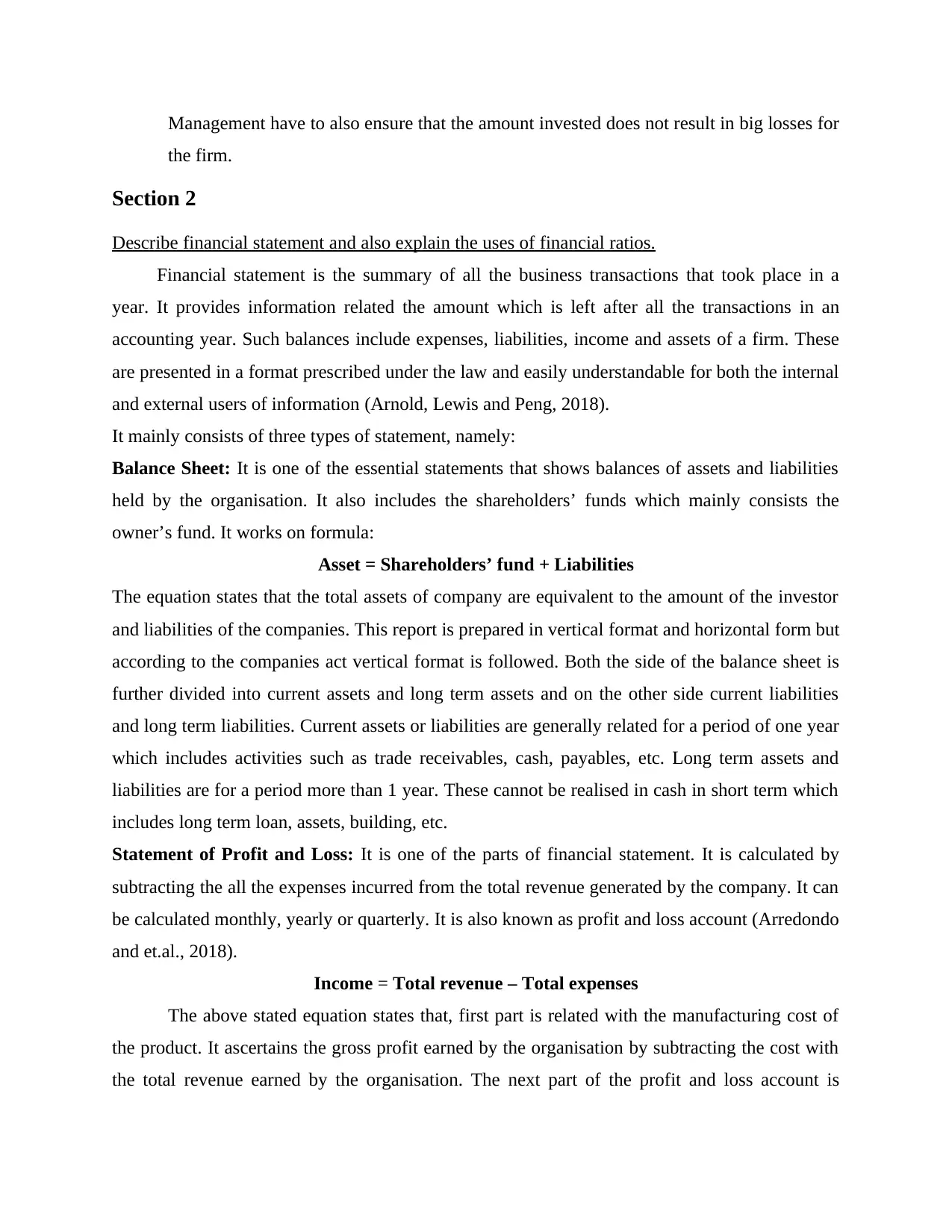
Management have to also ensure that the amount invested does not result in big losses for
the firm.
Section 2
Describe financial statement and also explain the uses of financial ratios.
Financial statement is the summary of all the business transactions that took place in a
year. It provides information related the amount which is left after all the transactions in an
accounting year. Such balances include expenses, liabilities, income and assets of a firm. These
are presented in a format prescribed under the law and easily understandable for both the internal
and external users of information (Arnold, Lewis and Peng, 2018).
It mainly consists of three types of statement, namely:
Balance Sheet: It is one of the essential statements that shows balances of assets and liabilities
held by the organisation. It also includes the shareholders’ funds which mainly consists the
owner’s fund. It works on formula:
Asset = Shareholders’ fund + Liabilities
The equation states that the total assets of company are equivalent to the amount of the investor
and liabilities of the companies. This report is prepared in vertical format and horizontal form but
according to the companies act vertical format is followed. Both the side of the balance sheet is
further divided into current assets and long term assets and on the other side current liabilities
and long term liabilities. Current assets or liabilities are generally related for a period of one year
which includes activities such as trade receivables, cash, payables, etc. Long term assets and
liabilities are for a period more than 1 year. These cannot be realised in cash in short term which
includes long term loan, assets, building, etc.
Statement of Profit and Loss: It is one of the parts of financial statement. It is calculated by
subtracting the all the expenses incurred from the total revenue generated by the company. It can
be calculated monthly, yearly or quarterly. It is also known as profit and loss account (Arredondo
and et.al., 2018).
Income = Total revenue – Total expenses
The above stated equation states that, first part is related with the manufacturing cost of
the product. It ascertains the gross profit earned by the organisation by subtracting the cost with
the total revenue earned by the organisation. The next part of the profit and loss account is
the firm.
Section 2
Describe financial statement and also explain the uses of financial ratios.
Financial statement is the summary of all the business transactions that took place in a
year. It provides information related the amount which is left after all the transactions in an
accounting year. Such balances include expenses, liabilities, income and assets of a firm. These
are presented in a format prescribed under the law and easily understandable for both the internal
and external users of information (Arnold, Lewis and Peng, 2018).
It mainly consists of three types of statement, namely:
Balance Sheet: It is one of the essential statements that shows balances of assets and liabilities
held by the organisation. It also includes the shareholders’ funds which mainly consists the
owner’s fund. It works on formula:
Asset = Shareholders’ fund + Liabilities
The equation states that the total assets of company are equivalent to the amount of the investor
and liabilities of the companies. This report is prepared in vertical format and horizontal form but
according to the companies act vertical format is followed. Both the side of the balance sheet is
further divided into current assets and long term assets and on the other side current liabilities
and long term liabilities. Current assets or liabilities are generally related for a period of one year
which includes activities such as trade receivables, cash, payables, etc. Long term assets and
liabilities are for a period more than 1 year. These cannot be realised in cash in short term which
includes long term loan, assets, building, etc.
Statement of Profit and Loss: It is one of the parts of financial statement. It is calculated by
subtracting the all the expenses incurred from the total revenue generated by the company. It can
be calculated monthly, yearly or quarterly. It is also known as profit and loss account (Arredondo
and et.al., 2018).
Income = Total revenue – Total expenses
The above stated equation states that, first part is related with the manufacturing cost of
the product. It ascertains the gross profit earned by the organisation by subtracting the cost with
the total revenue earned by the organisation. The next part of the profit and loss account is
Paraphrase This Document
Need a fresh take? Get an instant paraphrase of this document with our AI Paraphraser
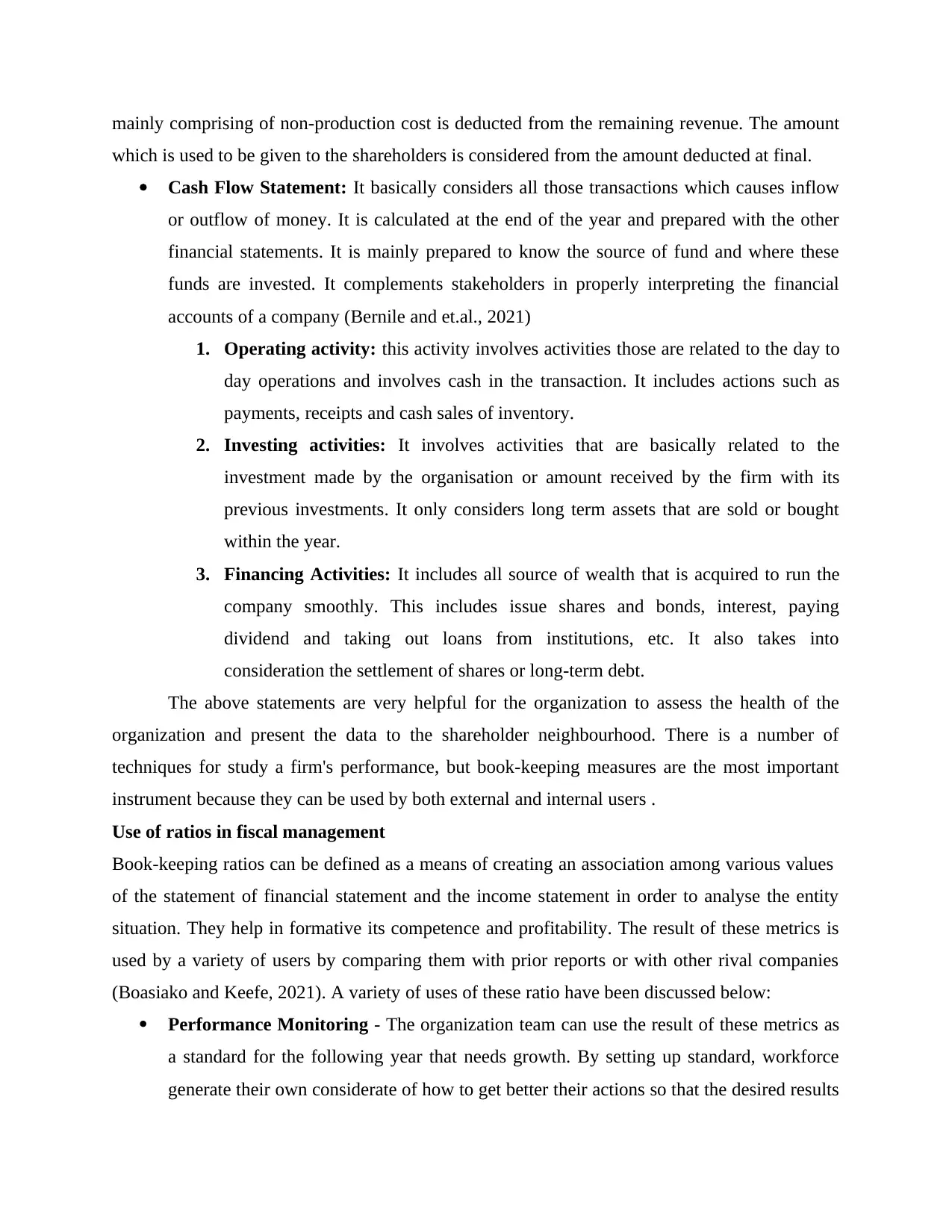
mainly comprising of non-production cost is deducted from the remaining revenue. The amount
which is used to be given to the shareholders is considered from the amount deducted at final.
Cash Flow Statement: It basically considers all those transactions which causes inflow
or outflow of money. It is calculated at the end of the year and prepared with the other
financial statements. It is mainly prepared to know the source of fund and where these
funds are invested. It complements stakeholders in properly interpreting the financial
accounts of a company (Bernile and et.al., 2021)
1. Operating activity: this activity involves activities those are related to the day to
day operations and involves cash in the transaction. It includes actions such as
payments, receipts and cash sales of inventory.
2. Investing activities: It involves activities that are basically related to the
investment made by the organisation or amount received by the firm with its
previous investments. It only considers long term assets that are sold or bought
within the year.
3. Financing Activities: It includes all source of wealth that is acquired to run the
company smoothly. This includes issue shares and bonds, interest, paying
dividend and taking out loans from institutions, etc. It also takes into
consideration the settlement of shares or long-term debt.
The above statements are very helpful for the organization to assess the health of the
organization and present the data to the shareholder neighbourhood. There is a number of
techniques for study a firm's performance, but book-keeping measures are the most important
instrument because they can be used by both external and internal users .
Use of ratios in fiscal management
Book-keeping ratios can be defined as a means of creating an association among various values
of the statement of financial statement and the income statement in order to analyse the entity
situation. They help in formative its competence and profitability. The result of these metrics is
used by a variety of users by comparing them with prior reports or with other rival companies
(Boasiako and Keefe, 2021). A variety of uses of these ratio have been discussed below:
Performance Monitoring - The organization team can use the result of these metrics as
a standard for the following year that needs growth. By setting up standard, workforce
generate their own considerate of how to get better their actions so that the desired results
which is used to be given to the shareholders is considered from the amount deducted at final.
Cash Flow Statement: It basically considers all those transactions which causes inflow
or outflow of money. It is calculated at the end of the year and prepared with the other
financial statements. It is mainly prepared to know the source of fund and where these
funds are invested. It complements stakeholders in properly interpreting the financial
accounts of a company (Bernile and et.al., 2021)
1. Operating activity: this activity involves activities those are related to the day to
day operations and involves cash in the transaction. It includes actions such as
payments, receipts and cash sales of inventory.
2. Investing activities: It involves activities that are basically related to the
investment made by the organisation or amount received by the firm with its
previous investments. It only considers long term assets that are sold or bought
within the year.
3. Financing Activities: It includes all source of wealth that is acquired to run the
company smoothly. This includes issue shares and bonds, interest, paying
dividend and taking out loans from institutions, etc. It also takes into
consideration the settlement of shares or long-term debt.
The above statements are very helpful for the organization to assess the health of the
organization and present the data to the shareholder neighbourhood. There is a number of
techniques for study a firm's performance, but book-keeping measures are the most important
instrument because they can be used by both external and internal users .
Use of ratios in fiscal management
Book-keeping ratios can be defined as a means of creating an association among various values
of the statement of financial statement and the income statement in order to analyse the entity
situation. They help in formative its competence and profitability. The result of these metrics is
used by a variety of users by comparing them with prior reports or with other rival companies
(Boasiako and Keefe, 2021). A variety of uses of these ratio have been discussed below:
Performance Monitoring - The organization team can use the result of these metrics as
a standard for the following year that needs growth. By setting up standard, workforce
generate their own considerate of how to get better their actions so that the desired results
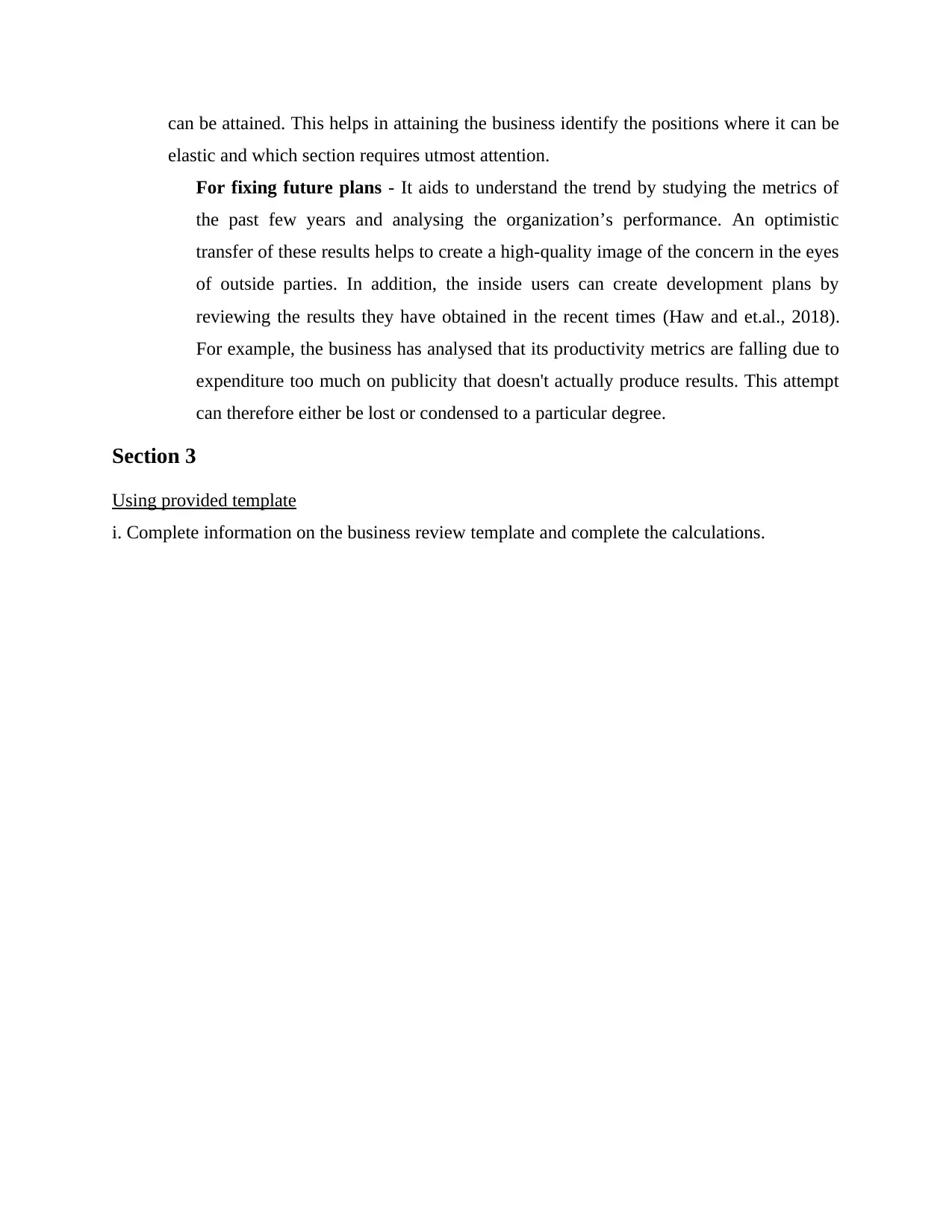
can be attained. This helps in attaining the business identify the positions where it can be
elastic and which section requires utmost attention.
For fixing future plans - It aids to understand the trend by studying the metrics of
the past few years and analysing the organization’s performance. An optimistic
transfer of these results helps to create a high-quality image of the concern in the eyes
of outside parties. In addition, the inside users can create development plans by
reviewing the results they have obtained in the recent times (Haw and et.al., 2018).
For example, the business has analysed that its productivity metrics are falling due to
expenditure too much on publicity that doesn't actually produce results. This attempt
can therefore either be lost or condensed to a particular degree.
Section 3
Using provided template
i. Complete information on the business review template and complete the calculations.
elastic and which section requires utmost attention.
For fixing future plans - It aids to understand the trend by studying the metrics of
the past few years and analysing the organization’s performance. An optimistic
transfer of these results helps to create a high-quality image of the concern in the eyes
of outside parties. In addition, the inside users can create development plans by
reviewing the results they have obtained in the recent times (Haw and et.al., 2018).
For example, the business has analysed that its productivity metrics are falling due to
expenditure too much on publicity that doesn't actually produce results. This attempt
can therefore either be lost or condensed to a particular degree.
Section 3
Using provided template
i. Complete information on the business review template and complete the calculations.
⊘ This is a preview!⊘
Do you want full access?
Subscribe today to unlock all pages.

Trusted by 1+ million students worldwide
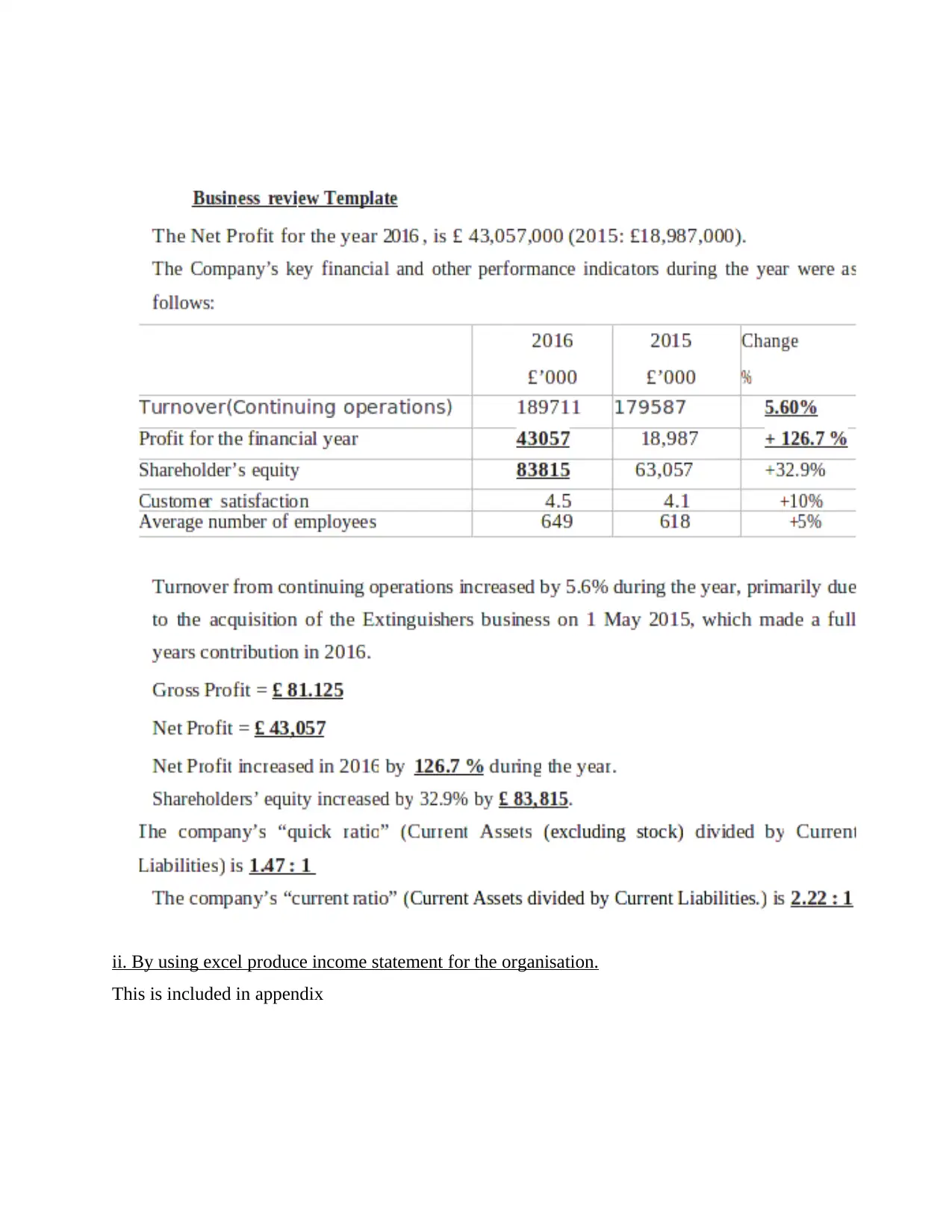
ii. By using excel produce income statement for the organisation.
This is included in appendix
This is included in appendix
Paraphrase This Document
Need a fresh take? Get an instant paraphrase of this document with our AI Paraphraser
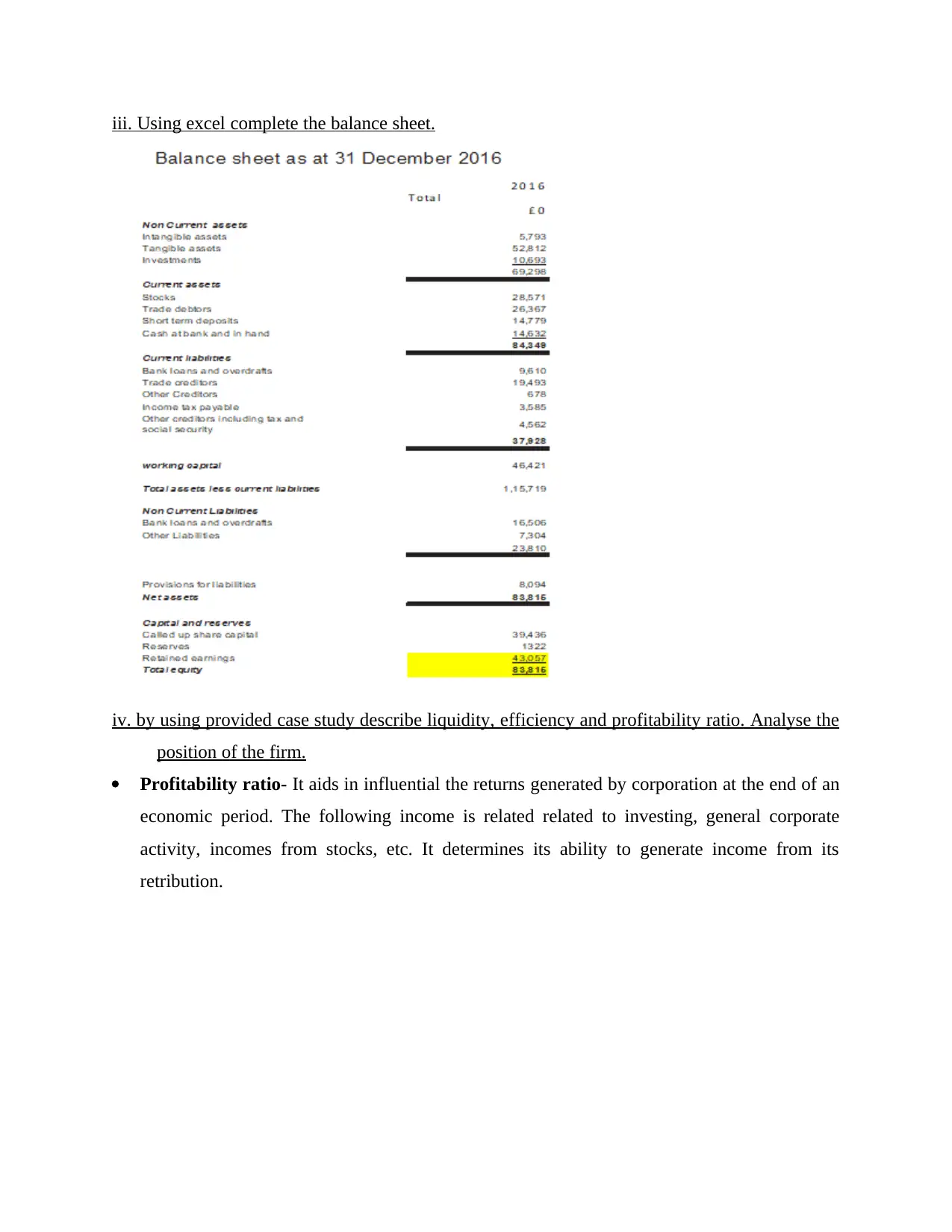
iii. Using excel complete the balance sheet.
iv. by using provided case study describe liquidity, efficiency and profitability ratio. Analyse the
position of the firm.
Profitability ratio- It aids in influential the returns generated by corporation at the end of an
economic period. The following income is related related to investing, general corporate
activity, incomes from stocks, etc. It determines its ability to generate income from its
retribution.
iv. by using provided case study describe liquidity, efficiency and profitability ratio. Analyse the
position of the firm.
Profitability ratio- It aids in influential the returns generated by corporation at the end of an
economic period. The following income is related related to investing, general corporate
activity, incomes from stocks, etc. It determines its ability to generate income from its
retribution.
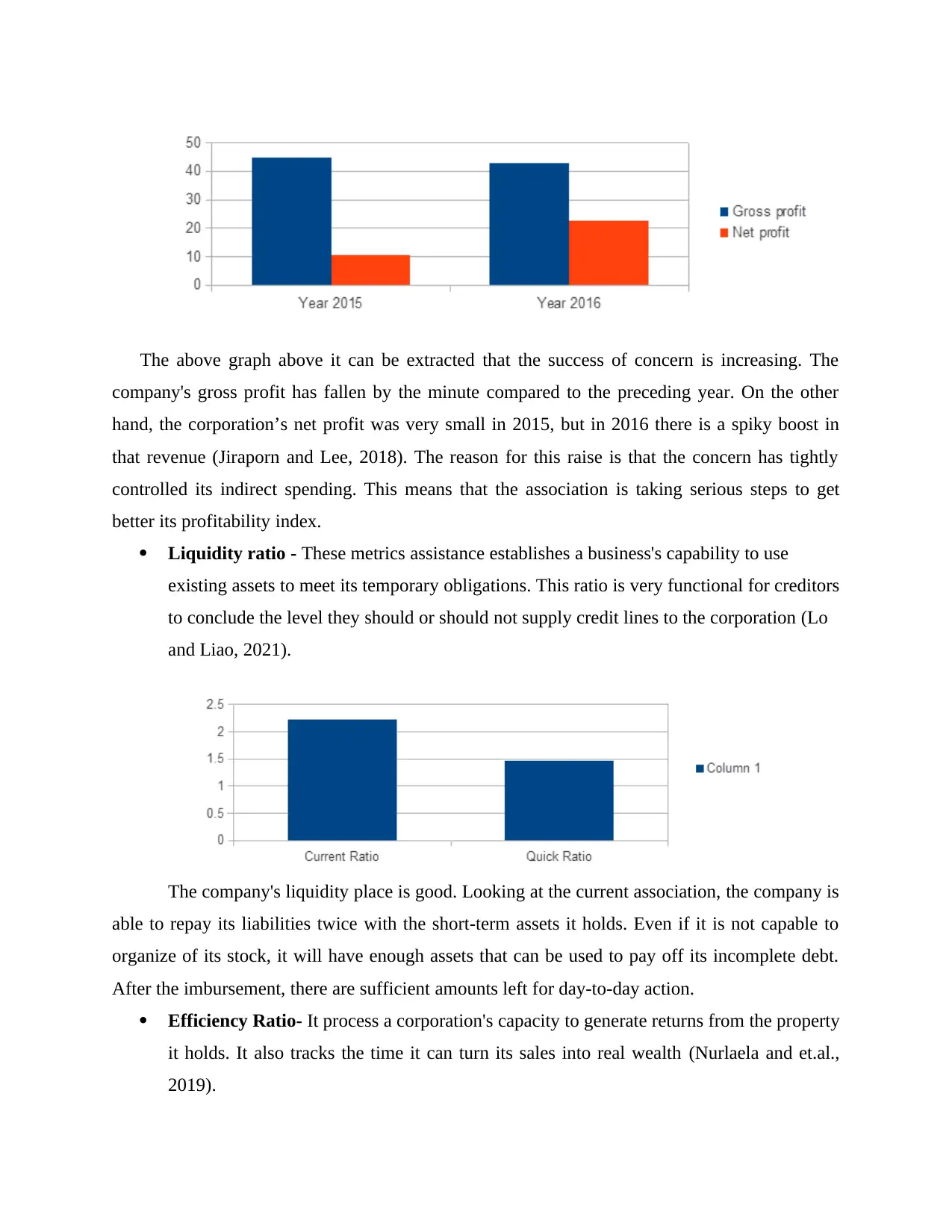
The above graph above it can be extracted that the success of concern is increasing. The
company's gross profit has fallen by the minute compared to the preceding year. On the other
hand, the corporation’s net profit was very small in 2015, but in 2016 there is a spiky boost in
that revenue (Jiraporn and Lee, 2018). The reason for this raise is that the concern has tightly
controlled its indirect spending. This means that the association is taking serious steps to get
better its profitability index.
Liquidity ratio - These metrics assistance establishes a business's capability to use
existing assets to meet its temporary obligations. This ratio is very functional for creditors
to conclude the level they should or should not supply credit lines to the corporation (Lo
and Liao, 2021).
The company's liquidity place is good. Looking at the current association, the company is
able to repay its liabilities twice with the short-term assets it holds. Even if it is not capable to
organize of its stock, it will have enough assets that can be used to pay off its incomplete debt.
After the imbursement, there are sufficient amounts left for day-to-day action.
Efficiency Ratio- It process a corporation's capacity to generate returns from the property
it holds. It also tracks the time it can turn its sales into real wealth (Nurlaela and et.al.,
2019).
company's gross profit has fallen by the minute compared to the preceding year. On the other
hand, the corporation’s net profit was very small in 2015, but in 2016 there is a spiky boost in
that revenue (Jiraporn and Lee, 2018). The reason for this raise is that the concern has tightly
controlled its indirect spending. This means that the association is taking serious steps to get
better its profitability index.
Liquidity ratio - These metrics assistance establishes a business's capability to use
existing assets to meet its temporary obligations. This ratio is very functional for creditors
to conclude the level they should or should not supply credit lines to the corporation (Lo
and Liao, 2021).
The company's liquidity place is good. Looking at the current association, the company is
able to repay its liabilities twice with the short-term assets it holds. Even if it is not capable to
organize of its stock, it will have enough assets that can be used to pay off its incomplete debt.
After the imbursement, there are sufficient amounts left for day-to-day action.
Efficiency Ratio- It process a corporation's capacity to generate returns from the property
it holds. It also tracks the time it can turn its sales into real wealth (Nurlaela and et.al.,
2019).
⊘ This is a preview!⊘
Do you want full access?
Subscribe today to unlock all pages.

Trusted by 1+ million students worldwide
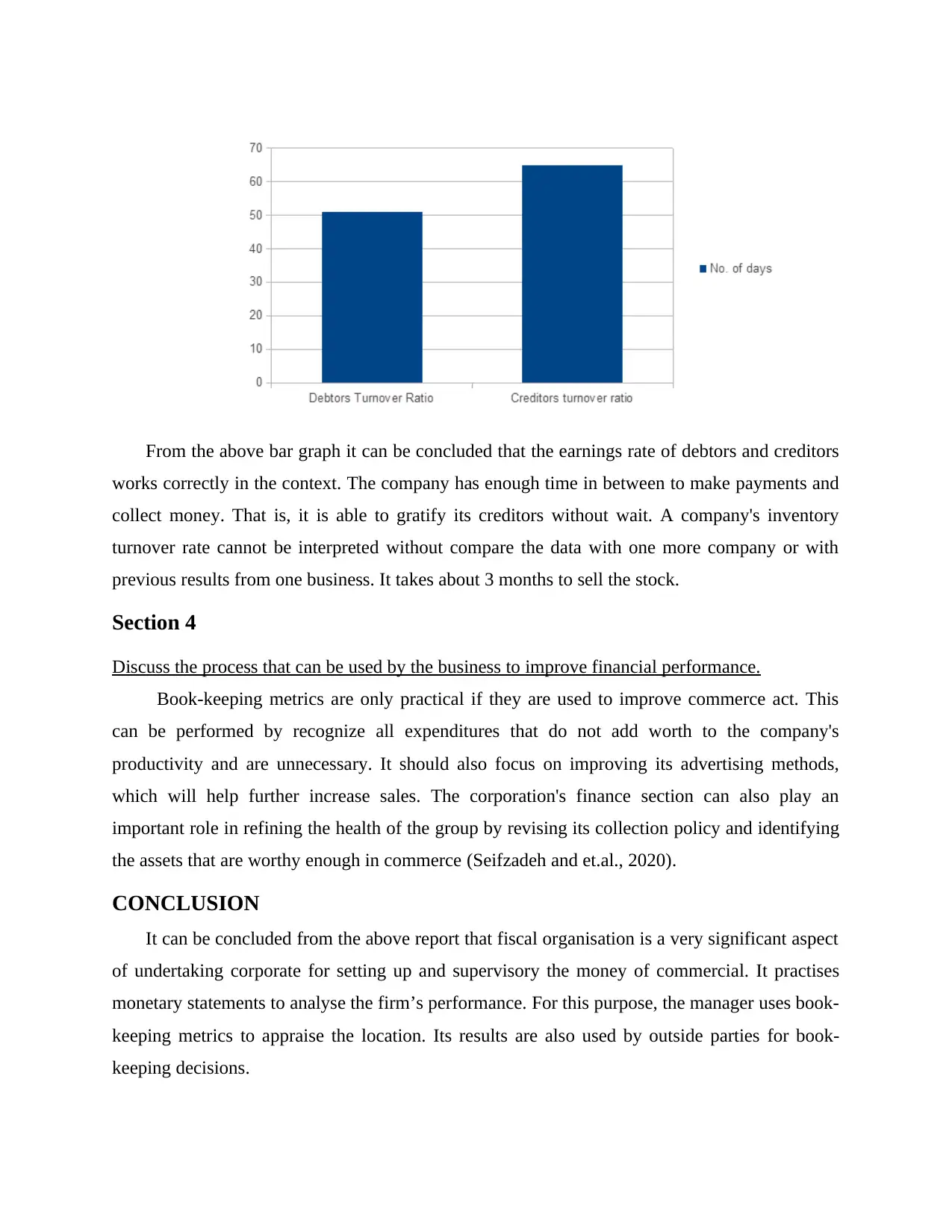
From the above bar graph it can be concluded that the earnings rate of debtors and creditors
works correctly in the context. The company has enough time in between to make payments and
collect money. That is, it is able to gratify its creditors without wait. A company's inventory
turnover rate cannot be interpreted without compare the data with one more company or with
previous results from one business. It takes about 3 months to sell the stock.
Section 4
Discuss the process that can be used by the business to improve financial performance.
Book-keeping metrics are only practical if they are used to improve commerce act. This
can be performed by recognize all expenditures that do not add worth to the company's
productivity and are unnecessary. It should also focus on improving its advertising methods,
which will help further increase sales. The corporation's finance section can also play an
important role in refining the health of the group by revising its collection policy and identifying
the assets that are worthy enough in commerce (Seifzadeh and et.al., 2020).
CONCLUSION
It can be concluded from the above report that fiscal organisation is a very significant aspect
of undertaking corporate for setting up and supervisory the money of commercial. It practises
monetary statements to analyse the firm’s performance. For this purpose, the manager uses book-
keeping metrics to appraise the location. Its results are also used by outside parties for book-
keeping decisions.
works correctly in the context. The company has enough time in between to make payments and
collect money. That is, it is able to gratify its creditors without wait. A company's inventory
turnover rate cannot be interpreted without compare the data with one more company or with
previous results from one business. It takes about 3 months to sell the stock.
Section 4
Discuss the process that can be used by the business to improve financial performance.
Book-keeping metrics are only practical if they are used to improve commerce act. This
can be performed by recognize all expenditures that do not add worth to the company's
productivity and are unnecessary. It should also focus on improving its advertising methods,
which will help further increase sales. The corporation's finance section can also play an
important role in refining the health of the group by revising its collection policy and identifying
the assets that are worthy enough in commerce (Seifzadeh and et.al., 2020).
CONCLUSION
It can be concluded from the above report that fiscal organisation is a very significant aspect
of undertaking corporate for setting up and supervisory the money of commercial. It practises
monetary statements to analyse the firm’s performance. For this purpose, the manager uses book-
keeping metrics to appraise the location. Its results are also used by outside parties for book-
keeping decisions.
Paraphrase This Document
Need a fresh take? Get an instant paraphrase of this document with our AI Paraphraser

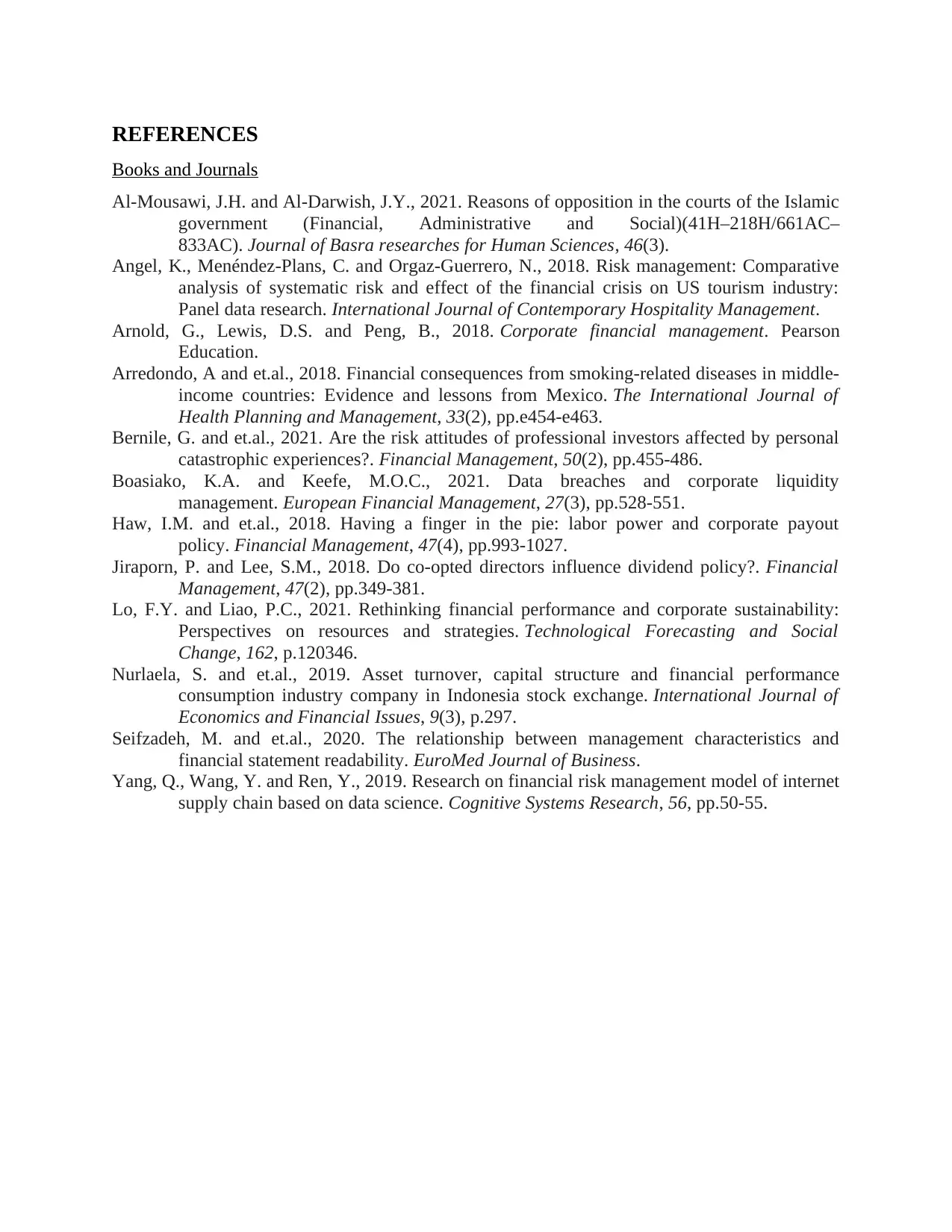
REFERENCES
Books and Journals
Al-Mousawi, J.H. and Al-Darwish, J.Y., 2021. Reasons of opposition in the courts of the Islamic
government (Financial, Administrative and Social)(41H–218H/661AC–
833AC). Journal of Basra researches for Human Sciences, 46(3).
Angel, K., Menéndez-Plans, C. and Orgaz-Guerrero, N., 2018. Risk management: Comparative
analysis of systematic risk and effect of the financial crisis on US tourism industry:
Panel data research. International Journal of Contemporary Hospitality Management.
Arnold, G., Lewis, D.S. and Peng, B., 2018. Corporate financial management. Pearson
Education.
Arredondo, A and et.al., 2018. Financial consequences from smoking‐related diseases in middle‐
income countries: Evidence and lessons from Mexico. The International Journal of
Health Planning and Management, 33(2), pp.e454-e463.
Bernile, G. and et.al., 2021. Are the risk attitudes of professional investors affected by personal
catastrophic experiences?. Financial Management, 50(2), pp.455-486.
Boasiako, K.A. and Keefe, M.O.C., 2021. Data breaches and corporate liquidity
management. European Financial Management, 27(3), pp.528-551.
Haw, I.M. and et.al., 2018. Having a finger in the pie: labor power and corporate payout
policy. Financial Management, 47(4), pp.993-1027.
Jiraporn, P. and Lee, S.M., 2018. Do co‐opted directors influence dividend policy?. Financial
Management, 47(2), pp.349-381.
Lo, F.Y. and Liao, P.C., 2021. Rethinking financial performance and corporate sustainability:
Perspectives on resources and strategies. Technological Forecasting and Social
Change, 162, p.120346.
Nurlaela, S. and et.al., 2019. Asset turnover, capital structure and financial performance
consumption industry company in Indonesia stock exchange. International Journal of
Economics and Financial Issues, 9(3), p.297.
Seifzadeh, M. and et.al., 2020. The relationship between management characteristics and
financial statement readability. EuroMed Journal of Business.
Yang, Q., Wang, Y. and Ren, Y., 2019. Research on financial risk management model of internet
supply chain based on data science. Cognitive Systems Research, 56, pp.50-55.
Books and Journals
Al-Mousawi, J.H. and Al-Darwish, J.Y., 2021. Reasons of opposition in the courts of the Islamic
government (Financial, Administrative and Social)(41H–218H/661AC–
833AC). Journal of Basra researches for Human Sciences, 46(3).
Angel, K., Menéndez-Plans, C. and Orgaz-Guerrero, N., 2018. Risk management: Comparative
analysis of systematic risk and effect of the financial crisis on US tourism industry:
Panel data research. International Journal of Contemporary Hospitality Management.
Arnold, G., Lewis, D.S. and Peng, B., 2018. Corporate financial management. Pearson
Education.
Arredondo, A and et.al., 2018. Financial consequences from smoking‐related diseases in middle‐
income countries: Evidence and lessons from Mexico. The International Journal of
Health Planning and Management, 33(2), pp.e454-e463.
Bernile, G. and et.al., 2021. Are the risk attitudes of professional investors affected by personal
catastrophic experiences?. Financial Management, 50(2), pp.455-486.
Boasiako, K.A. and Keefe, M.O.C., 2021. Data breaches and corporate liquidity
management. European Financial Management, 27(3), pp.528-551.
Haw, I.M. and et.al., 2018. Having a finger in the pie: labor power and corporate payout
policy. Financial Management, 47(4), pp.993-1027.
Jiraporn, P. and Lee, S.M., 2018. Do co‐opted directors influence dividend policy?. Financial
Management, 47(2), pp.349-381.
Lo, F.Y. and Liao, P.C., 2021. Rethinking financial performance and corporate sustainability:
Perspectives on resources and strategies. Technological Forecasting and Social
Change, 162, p.120346.
Nurlaela, S. and et.al., 2019. Asset turnover, capital structure and financial performance
consumption industry company in Indonesia stock exchange. International Journal of
Economics and Financial Issues, 9(3), p.297.
Seifzadeh, M. and et.al., 2020. The relationship between management characteristics and
financial statement readability. EuroMed Journal of Business.
Yang, Q., Wang, Y. and Ren, Y., 2019. Research on financial risk management model of internet
supply chain based on data science. Cognitive Systems Research, 56, pp.50-55.
⊘ This is a preview!⊘
Do you want full access?
Subscribe today to unlock all pages.

Trusted by 1+ million students worldwide
1 out of 14
Related Documents
Your All-in-One AI-Powered Toolkit for Academic Success.
+13062052269
info@desklib.com
Available 24*7 on WhatsApp / Email
![[object Object]](/_next/static/media/star-bottom.7253800d.svg)
Unlock your academic potential
Copyright © 2020–2025 A2Z Services. All Rights Reserved. Developed and managed by ZUCOL.



